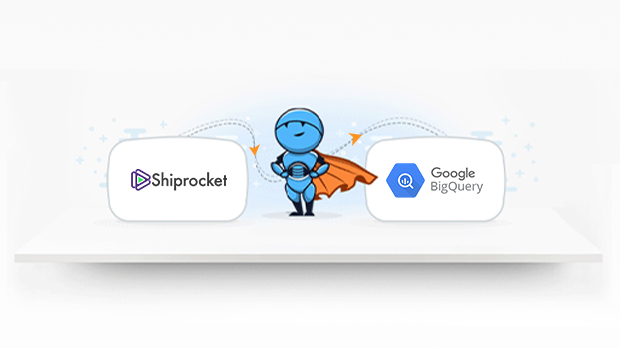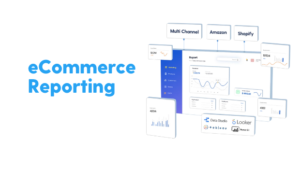Replicate Shiprocket to Google Bigquery in minute
Are you looking for a quicker way to transfer data from Shiprocket to Google Bigquery? Here is an easy solution for this data migration process using an ETL tool: Daton.
With increasing competition, a data-driven approach is of paramount importance in this age of business. E-Commerce companies specifically need to utilize their data to the fullest to stay ahead of their competition, reduce operational costs, increase efficiency and get insights on the business pulse, and make data-driven business decisions. eCommerce brands use shipping automation apps like Shiprocket to minimize losses through their shipping channels. Shiprocket generates data like return rates of products, the reason for returning, average delivery time, most efficient delivery channels.
Top companies usually collect data from shipping automation tools and tally it with data generated by customer service apps, marketing platforms, CRMs to get meaningful insights. Behavioural patterns of users like wishlists, search history, cart addition, cart abandonment data, product returns provide great insights on product demand trends. All of this data can be used to project sales trends and allocate marketing, logistics and other budgets accordingly to optimize profits. Businesses continuously mine and analyze these valuable data to gain better insights and revenue.
Why integrate Shiprocket to Google Bigquery
An Online seller can have multiple logistic management platforms like Shiprocket, where a ton of data is generated. If he wants to allocate his funds to the best shipping partner, he needs to consolidate data from all the tools to a centralized data warehouse and compare their performance. You get transactional, and product returns data from the logistics platform, which will indicate the profitable source or channels. The feedback, review data from the customer support platform after delivering a product will help strategize effective remarketing campaigns. So, centralize inventory, customer feedback, customer behaviour, payment gateway data, shipping and logistics data to get a consolidated picture of the entire business. This process takes a lot of time and effort to execute manually, and the analysis would not be very accurate. Thus, companies lose out on potential revenue.
Top companies use a cloud data pipeline and data warehouse like Google Bigquery to consolidate all the data. Consolidation enables easier reporting and faster analysis and decisive actions. Daton is a highly automated data pipeline that easily fetches data from Shiprocket into Bigquery without any coding or maintenance.
Shiprocket Overview
Shiprocket is a popular shipping management software that offers automated logistics solutions. Users can ship goods anywhere in India and abroad, along with receiving discounted rates. It also lets users expand their e-Commerce business by providing a better shipping quality for more outreach. Shiprocket facilitates around 50,000 cost-effective deliveries of orders daily and caters to about 220 countries. The platform is integrated with 17 top courier services, which make transportation secure and reliable. Shiprocket gets the maximum insurance coverage for their lost shipments. It offers both prepaid and cash-on-delivery payment options. Thus, users get the freedom to choose without worrying. The customers can also track the whereabouts of their products by SMS or email notifications. For undelivered items, they can select their location preference accordingly. A tracking page for users contains support information, marketing banners, and a net promoter score to determine the customer-business relationship.
Google Bigquery Overview
Google BigQuery is the first serverless data warehouse-as-a-service offered in the market. A database administrator’s role in a Google BigQuery environment is to architect the schema and optimize the partitions for performance and cost. This cloud service automatically scales to fulfil any query’s demands without the intervention of a database administrator. Google BigQuery service offers an unusual pricing model based on the amount of data processed by incoming queries, not on the storage or the compute capacity needed to process your queries. The best part about Google BigQuery is that you can instantly load data to the service and start using it. You need a mechanism to load data into Google BigQuery and the ability to write SQL queries.
How to replicate Shiprocket to Google Bigquery
There are two ways in which you can replicate Shiprocket to Google Bigquery warehouse.
Build a Data Pipeline
This process needs much experience and consumes a lot of time and manpower. The chances of errors are more. You need to extract data using Shiprocket APIs & then connect it properly with Google Bigquery data warehouse.
Use Daton to integrate Shiprocket & Google Bigquery
Use Daton to integrate Shiprocket & Google Bigquery is the fastest & easiest way to save your time and efforts. Leveraging an eCommerce data pipeline like Daton significantly accelerates and simplifies the time it takes to build automated reporting.
Configuring data replication on Daton only takes a few minutes and a few clicks. You won’t require any code or manage any infrastructure, yet they can access their Shiprocket data in a few hours.
Daton is easy and simple to use. The interface allows analysts and developers to use UI elements to configure data replication from Shiprocket data into Google Bigquery.
Daton takes care of:
- Authentication
- Rate limits,
- Sampling,
- Historical data load,
- Incremental data load,
- Table creation, deletion and reloads.
- Refreshing access tokens,
- Notifications
And many more important features to help analysts so that they can focus more on data analysis rather than worry about the data migration.
Steps to Integrate Shiprocket with Daton

1. Sign in to Daton
2. Select Shiprocket from the Integrations page
3. Provide Integration Name, Replication Frequency, and History. The integration name cannot be changed later as it would be used in creating tables for the integration.
4. You will be redirected to the Shiprocket login page for authorizing Daton to extract data periodically.
5. Post successful authentication, you will be prompted to choose from the list of available ShiprocketAd accounts
6. Select the required tables from the available list of tables
7. Then select all required fields for each table
8. Submit the integration
Here are more reasons to explore Daton for Shiprocket to Google Bigquery Integration
- Faster Integration of Shiprocket to Google Bigquery– Shiprocket to Google Bigquery is one of the integrations Daton can handle very fast and seamlessly. By following a few steps, you can easily connect Shiprocket to Google Bigquery.
- Low Effort & Zero Maintenance: Daton takes care of all the data replication processes and infrastructure automatically once you sign up for a Daton account and configure the data sources without writing codes or requiring any maintenance.
- You get an incredibly friendly customer support team who ensures that you leave the data engineering to Daton and focus on analysis and insights.
- It is an Enterprise-grade data pipeline at an unbeatable price to help every business become data-driven. Get started today for just $10 with a single integration and scale up as your demands increase.
- Robust Scheduling Options: allows you to schedule jobs based on their requirements using a simple configuration step.
- Daton supports popular cloud data warehouses like Snowflake, Google Bigquery, Amazon Redshift, Oracle Autonomous Data Warehouse, PostgreSQL and more.
- Flexible loading options allows optimizing data loading behaviour to maximize storage utilization and ease of querying.
- Enterprise-grade encryption gives your peace of mind.
- Support for 100+ data sources: In addition to Shiprocket, Daton can extract data from various resources like Databases, Sales and Marketing applications, Analytics and Payment platforms. Daton will ensure that all useful data can be transferred to Google Bigquery for generating relevant insights.
For all sources, check our data connectors page.
We Saras Analytics can help with our eCommerce-focused Data pipeline (Daton) and custom ML and AI solutions to ensure you always have the correct data at the right time. Request a demo and envision how reporting is supercharged with a 360° view.
Other Articles by Saras Analytics,
- 10 Ways To Support Data Analytics Team
- Amazon Aggregators
- Product Sequencing in eCommerce
- Advanced Analytics in Merchandising
- User and Marketing Event Tagging
- Low Effort and Zero Upkeep: Once you sign up for a Daton account and configure the data sources, Daton takes care of all the data replication processes and infrastructure automatically without writing any code or maintaining anything.
- Daton's extremely welcoming customer support ensures you concentrate on analysis and insights rather than data engineering.
- Daton provides an enterprise-quality data pipeline at an unbeatable cost to help businesses become data-driven. Start with a single integration for just $10 and grow as your needs grow.
- Flexible Scheduling Choices: You can use a single configuration step to schedule jobs according to their requirements.
- Daton is compatible with various famous cloud data warehouses, including PostgreSQL, Google Bigquery, Amazon Redshift, and Oracle Autonomous Data Warehouse.













